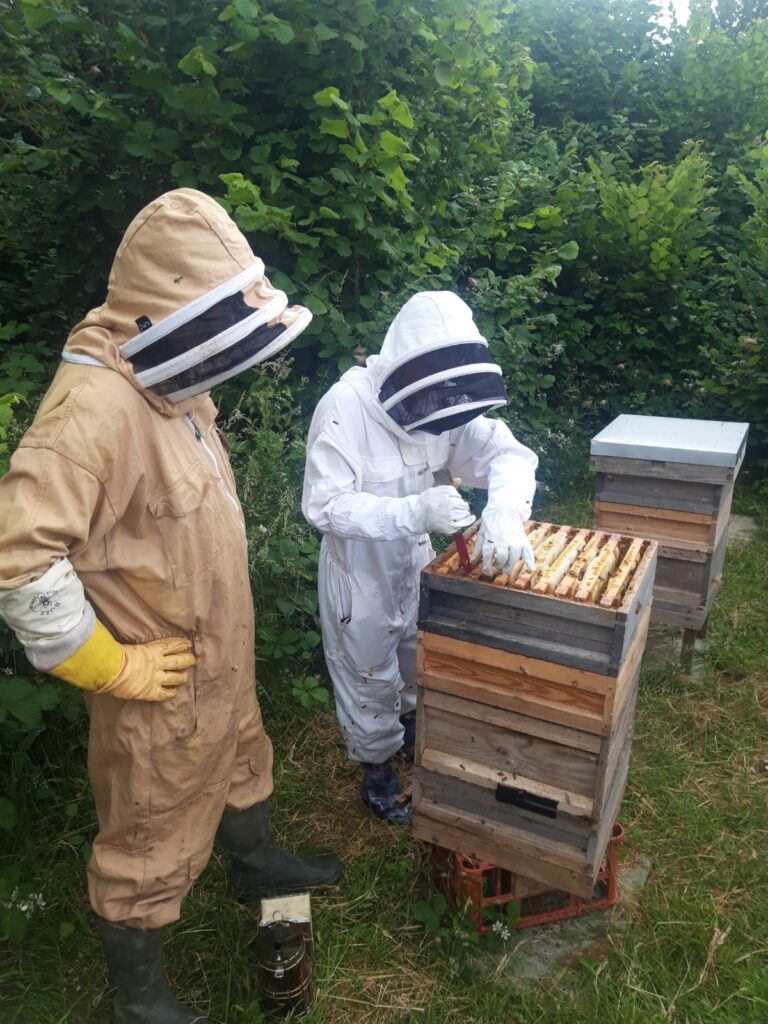I can’t help but smile when I catch sight of a bee. Bumblebees, Mason bees and Mining bees are just one small part of a big family but only one kind makes honey; the honeybee. You might be surprised to learn that there are more than 250 types of bees in the UK. Bees and other pollinators have huge positive effects on the whole ecosystem, increasing biodiversity and natural habitats.

Beekeeping
Recently I went on a beekeeping course that was bought for me for my birthday. The course covered identification of honey bees and the different types of beehives you can keep them in. All the different parts to a bee hive and their role in a successful hive. The lifecycle of a honeybee and the hives health and welfare is paramount to it success.

Bee colonies are a hive of activity which is made up of one queen, hundred of male drones and thousands of female workers. The queen lays eggs whilst the workers care for the young. Every year a new queen will either take the place of her mother, or she will leave to start a colony of her own.
How can you tell the difference between bees?
The honeybee is different from the bumblebee in that they are slimmer and they have a striped golden body. They are one of the more endangered UK bee species, feeding on both annuals and perennial flowers. We have just one species of honeybee in the UK. It’s a domesticated species introduced by beekeepers, it’s now incredible rare to find our native wild honeybee species in the UK.
How is honey made?
A bee forages from flower to flower and collects nectar through a specially evolved tongue called a proboscis. The nectar is taken back to the hive and the bee stores it in a special organ called the honey stomach.
Back at the hive, the forager bee passes the collected nectar to younger house bees. This process is done mouth to mouth and helps further break down the sugars and begins to reduce the water content of nectar.
The nectar is then deposited into hexagonal cells in the honeycomb, where the bees will fan their wings to reduce the water content of nectar further. When the water content gets below 20% the honey is ready and the bees will seal the honeycomb cell with a wax capping, meaning the honey is now preserved indefinitely.

What is honey made of?
Honey has been used by humans for thousands of years. Bees eat two types of food, both of which come from flowers. Pollen is their protein source and nectar is their carbohydrate. Nectar is a sugary liquid produced by plants, with sucrose being the main sugar. Enzymes in the bees honey stomachs break this down into the simpler sugars glucose and fructose. Honey also contains vitamins, minerals, amino acids, enzymes and compounds from the flowers.
The unique flavours, fragrances and colours of different kinds of honey depend on the type of plants the nectar comes from. The average hive produces about 11kg honey during a season, so that’s the equivalent of about 24 jars.
Why do bees make honey?
Honey is a bees way of preserving their food so they have something to eat when there aren’t many flowers in bloom. Honey can be stored in the hive and consumed when needed. If bees stored nectar without turning it into honey first, it would ferment.
Did you know…
A single hive may contain as many as 50,000 individuals. During the winter months the hive goes into survival mode, drones are expelled, the workers huddle together to keep warm and the larvae are fed on stores of pollen and honey. When the season turns to spring a new generation of bees emerge.
Beekeeping is good for mental health and the environment. We all have our reasons for keeping bees, but there’s one main thing that we all look forward to….honey.



No Comments
Be the first to start a conversation